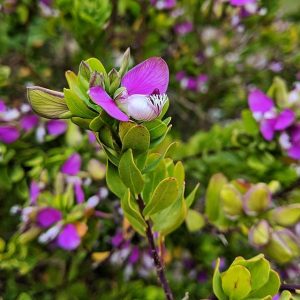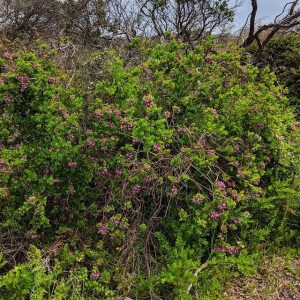Myrtle-leaf Milkwort (Polygala myrtifolia), a South African ornamental shrub and one of several dominant weeds in residential scrub around Port Phillip Bay, and on Mornington outer and the surf coast.
As with many other plants from the Cape Colony, botanical networks delivered Myrtle-leaf Milkwort to the incipient Australian colonies. It was reportedly listed in Adelaide nursery catalogues by 1845, and planted at Mt Eliza here in Victoria in 1851.
In the 1860s and 70s, Myrtle-leaf Milkwort was praised in Australian newspapers as a drought-tolerant and long-flowering selection that could be made through pruning to form an ‘exceedingly ornamental hedge’. Some noted an extra incentive for adoption, that ‘as it seeds abundantly, a large stock may quickly be attained.’
Beware the promises of anyone purporting to sell magic beans.
By 1889, this Milkwort was reportedly a difficult weed in many parts of Victoria and NSW, ‘spread[ing] itself over the adjacent pastures’, and listed among the ‘blunders of acclimatisation’ in a widely republished paper to the RHS. The plant was verifiably loose on Melbourne’s fluorescent coast by 1896, when it was collected at Brighton and Mentone. Populations are reported to have increased markedly in the 1980s and 1990s, thanks to increased use of mechanical land management techniques.
The photographed plants today form a major component in coastal scrub between St Andrews Beach and Rye Ocean Beach. The species is notably also found inland on riparian and infrastructural corridors in the metropolitan north and east.
View Original Post on Instagram
Search for information about Polygala myrtifolia in the Flora of Victoria
View information and occurrences of Polygala myrtifolia on the Atlas of Living Australia











